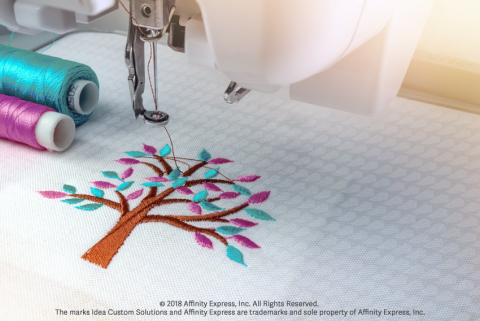Thinking of getting your customers’ logos embroidered? It’s a great choice! They will build on centuries of historical positivity at seeing an embroidered piece of art. Plus, the design style is booming right now and on-trend all over the runways. But where did embroidery begin and how has it gotten to the ubiquitous level it’s at today?

As long as fabric has existed, it appears that embroidery has as well. Archaeologists have even found fossilized examples of early embroidery on clothes, a hat and boots dating back to 30,000 BC (around the Cro-Magnon Era). Ancient Siberians, ranging from 5000 to 6000 BC used similar embroidery stitching when fastening shells onto animal hides. And the first example of ancient Chinese embroidery dates to 3500 BC, when silk threads created intricate designs including pearls and gemstones.
China perfected its embroidery techniques by the Middle Ages, at which point the style began to catch on in Japan and across Europe. It was originally reserved for religious relics — like wall hangings and robes — and for the elaborate gowns of royalty.
Then the Vikings caught on. Embroidered artifacts have been found in Sweden since the 800s. It was still reserved for high-class citizens at that point and, with the Viking Era dissolving into the Christian world, it became an even stronger force of religious expression and decoration. The wealthy and pious began to commission tapestries, tablecloths and other items that could display their influence.
From this period emerged the Bayeux Tapestry, which is one of the most famous examples of embroidery in history. It was sewn in 1067 and shows the Normans’ 1066 conquest of England.
The more embroidery appeared, the more it became accessible to regular citizens. From royalty, the practice moved into the homes of upper class people, where the women would routinely sit in embroidery circles and create small hooped pieces of art. Latin American embroidery emerged in the mid 1700s, inspired by patterns and designs of traditional body paint.
In 1828, embroidery got a bit more mechanical. That year, Josué Heilmann invented the first hand-embroidery machine, a piece of equipment designed to do the work of four stitchers at once. As with most technology, it started out as a huge device, which was big enough to take up an entire room. A designer operating the machine would trace a design with a mechanical arm that would then cause a reaction in a series of needles that worked like hand stitching. Each color was embroidered one at a time, to completion.
Heilmann’s hand-embroidery machine paved the way for Singer Sewing Company to compact and improve the mechanics, introducing the first multi-head embroidery machine in 1911. Home embroidery machines popped up in the 1950s and, in the 1980s, the first computerized versions emerged.
Idea Custom Solutions can put the history of embroidery behind your customers’ logos along with our decades of experience in digitizing. We know you need the quality to be top-notch for them and we can digitize customers logos for production on apparel, bags and other items so you earn their gratitude and repeat orders.

Add new comment